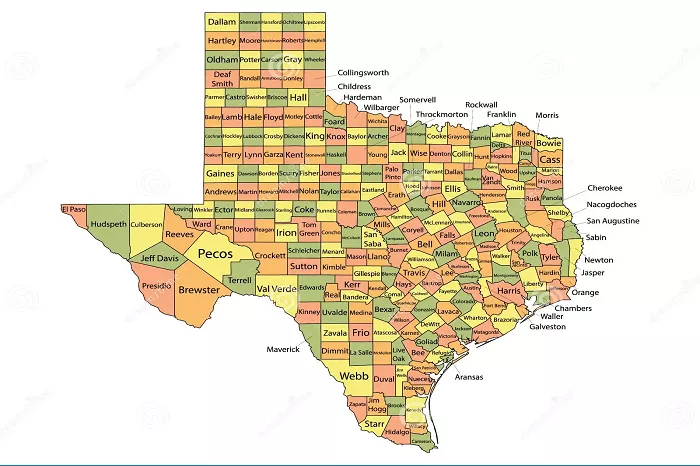Texas, known as the Lone Star State, is renowned for its vast expanse and rich history. One notable aspect of its administrative structure is its division into counties. Understanding the number and distribution of these counties provides insight into the state’s governance, geography, and development.
The Total Number of Counties in Texas
Texas is divided into 254 counties, more than any other state in the United States. This extensive division reflects the state’s large size and diverse regional needs. citeturn0search0
Historical Development of Texas Counties
The evolution of Texas’s county system is deeply rooted in its history:
- Early Settlements: Initially, Texas was part of Spanish and later Mexican territories, divided into large land grants and municipalities.
- Republic of Texas: After gaining independence in 1836, the Republic of Texas established 23 original counties, primarily along the eastern settlements.
- Statehood and Expansion: Upon joining the United States in 1845, Texas’s population grew, leading to the creation of additional counties to ensure local governance was accessible.
- Modern Configuration: The last county, Loving County, was established in 1931, finalizing the current count at 254. citeturn0search4
Reasons for the High Number of Counties
Several factors contribute to Texas having the highest number of counties in the U.S.:
- Geographical Size: Covering over 268,000 square miles, Texas’s vast area necessitated numerous counties to manage local affairs effectively.
- Accessibility: Historically, the aim was to ensure that residents could travel to their county seat within a day’s journey, leading to smaller, more numerous counties.
- Political Representation: Smaller counties allowed for more localized governance, ensuring that diverse communities had representation tailored to their unique needs.
Visualizing Texas Counties on a Map
Understanding the distribution of Texas’s 254 counties is facilitated through various mapping resources:
- Interactive Maps: The Texas Counties Interactive Map allows users to click on individual counties to learn more about each one.
- Detailed County Maps: Resources like the Texas County Map on Geology.com provide detailed visuals of county boundaries and seats.
- Official State Maps: The Texas Department of Transportation offers maps detailing county boundaries and district information.
Notable Counties in Texas
Among the 254 counties, several stand out due to their size, population, or historical significance:
- Harris County: Home to Houston, it’s the most populous county, with over 4.6 million residents. citeturn0search6
- Loving County: With fewer than 100 residents, it’s the least populous, highlighting the vast demographic range across Texas counties. citeturn0search6
- Brewster County: Covering over 6,000 square miles, it’s the largest by land area, encompassing much of Big Bend National Park.
- Rockwall County: At just 149 square miles, it’s the smallest by land area but has experienced rapid population growth in recent years.
Functions and Responsibilities of Texas Counties
Counties in Texas serve as essential administrative units, performing various functions:
- Law Enforcement: County sheriffs and constables oversee local law enforcement and maintain county jails.
- Judicial Administration: Counties manage courts that handle civil, criminal, and probate matters.
- Public Records: They maintain vital records, including birth, death, marriage, and property documents.
- Infrastructure Maintenance: Counties are responsible for the upkeep of local roads, bridges, and public facilities.
- Health and Safety Services: They provide public health services, emergency management, and disaster response coordination.
Challenges Facing Texas Counties
Despite their critical roles, Texas counties face several challenges:
- Population Disparities: The vast differences in population size can strain resources in rapidly growing counties, while sparsely populated ones may struggle with limited budgets.
- Economic Variations: Economic prosperity varies, with some counties benefiting from industries like oil and technology, while others face economic hardships.
- Infrastructure Demands: Maintaining and upgrading infrastructure to meet modern standards requires significant investment, especially in rapidly urbanizing areas.
The Future of Texas Counties
As Texas continues to grow and evolve, its counties will play pivotal roles in shaping its future:
- Urbanization: Counties encompassing major cities will need to address challenges related to urban sprawl, transportation, and housing.
- Rural Development: Efforts to revitalize rural counties may focus on attracting new industries, improving healthcare access, and enhancing educational opportunities.
- Technological Integration: Counties will increasingly adopt technology to improve public services, from digital record-keeping to online public engagement platforms.
Conclusion
The 254 counties of Texas reflect the state’s rich history, expansive geography, and commitment to localized governance. Each county, with its unique characteristics and challenges, contributes to the diverse tapestry that defines Texas. Understanding their distribution and functions provides valuable insight into the state’s administrative framework and the daily lives of its residents.

